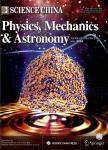Strong decays of the Pcs(4459) as a ■ molecule
Strong decays of the Pcs(4459) as a ■ molecule作者机构:School of Physical Science and TechnologySouthwest Jiaotong University Asia Pacific Center for Theoretical PhysicsPohang University of Science and Technology College of Physics and Electronic EngineeringChongqing Normal University
出 版 物:《Science China(Physics,Mechanics & Astronomy)》 (中国科学:物理学 力学 天文学(英文版))
年 卷 期:2021年第64卷第12期
页 面:108-114页
核心收录:
学科分类:08[工学] 0827[工学-核科学与技术] 082701[工学-核能科学与工程]
基 金:supported by the Science and Technology Research Program of Chongqing Municipal Education Commission (Grant No. KJQN201800510) the Opened Fund of the State Key Laboratory on Integrated Optoelectronics (Grant No. IOSKL2017KF19) the support from the Development and Exchange Platform for the Theoretic Physics of Southwest Jiaotong University (Grant Nos. 11947404, and 12047576) Fundamental Research Funds for the Central Universities (Grant No. 2682020CX70) National Natural Science Foundation of China (Grant No. 12005177)
主 题:molecular state strong decay effective Lagrangians 14.20.Mr 13.30.Eg 12.39.−x
摘 要:In this work, we study the strong decay of the newly observed Pcs(4459), assuming that it is a pure ■ molecular state. Considering two possible spin-parity assignments J~P= 1/2~- and J~P= 3/2~-, the partial decay widths of the ■ molecular state into ■ cfinal states through hadronic loops are evaluated with the help of the effective Lagrangians. In comparison with the LHCb data, the S-wave ■ cmolecular with J~P= 1/2-assignment for Pcs(4459) is supported by our study, while the Pcs(4459) in spin-parity J~P= 3/2-case may be explained as an S-wave coupled bound state with lager ■ *** addition, the calculated partial decay widths with ■ molecular state picture indicate that allowed decay mode,■, may have the biggest branching ratio. The experimental measurements for this strong decay process could be a crucial test for the molecule interpretation of the Pcs(4459).



